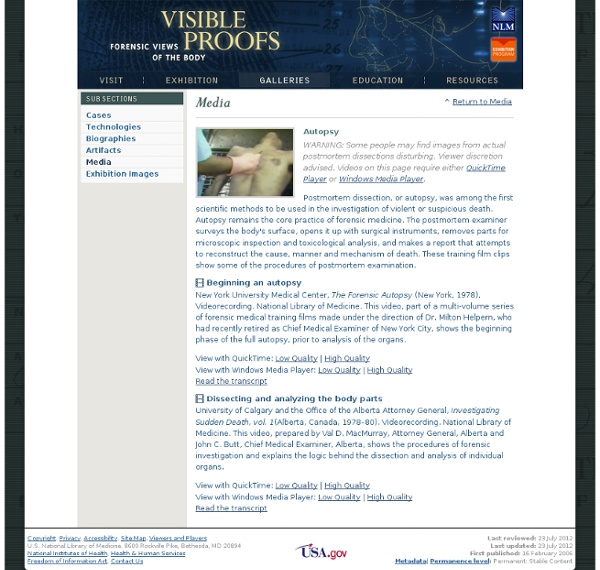Visible Proofs: Forensic Views of the Body: Galleries: Media: Autopsy
WARNING: Some people may find images from actual postmortem dissections disturbing. Viewer discretion advised. Videos on this page require either QuickTime Player or Windows Media Player. Postmortem dissection, or autopsy, was among the first scientific methods to be used in the investigation of violent or suspicious death. Autopsy remains the core practice of forensic medicine. Beginning an autopsy New York University Medical Center, The Forensic Autopsy (New York, 1978). View with QuickTime: Low Quality | High Quality View with Windows Media Player: Low Quality | High QualityRead the transcript Dissecting and analyzing the body parts University of Calgary and the Office of the Alberta Attorney General, Investigating Sudden Death, vol. 1(Alberta, Canada, 1978–80). View with QuickTime: Low Quality | High Quality View with Windows Media Player: Low Quality | High QualityRead the transcript
Mark Vernon
Do you ever get the feeling that something went wrong? What with credit crunches, wars, congestion charges, and unemployment, it is natural to hark back to less complicated times. In this witty and inspiring book, Mark Vernon does just that. However, we are not talking about the 1980s – try 400BC! Filled with timeless insight into life, relationships, work and partying, Plato's Podcasts takes a sideways glance at modern living and presents the would-be thoughts of Ancient Philosophers on various topics central to our 21st century existence. 'Bravo! ‘Ancient wisdom goes modern in this unique book. ‘Mark Vernon has an unparallelled ability to convey profound philosophical ideas in a manner that is both accessible and personal but also rigorous and challenging. ‘Vernon consistently does his own thinking, and invites the reader to join in… The writing is highly engaging, and [he] has a good eye for the colourfully weird detail.’Steven Poole, The Guardian
Russian Numbers - Russian Language Lesson 2 - Main Lesson - Russian Language Lessons
New Russian Audio: To help you learn Russian this lesson now has sound. Click the green icon to listen. (Help) The next step in learning Russian is to learn the Russian numbers. Russian numbers: 1 to 10 1 - один ("a-deen") 2 - два ("dva") 3 - три ("tree") 4 - четыре ("chye-tir-ye") 5 - пять ("pyat") 6 - шесть ("shest") 7 - семь ("syem") 8 - восемь ("vo-syem") 9 - девять ("dyev-yat") 10 -десять ("dyes-yat") Read through the numbers 1-10 a couple of times until you are comfortable with them. Russian numbers: 11 to 19 Now that you are comfortable with your first Russian numbers, try to learn the numbers from 11 to 19. 11 - одиннадцать 12 - двенадцать 13 - тринадцать 14 - четырнадцать 15 - пятнадцать 16 - шестнадцать 17 - семнадцать 18 - восемнадцать 19 - девятнадцать Russian numbers: 20 and onwards As you could see, the numbers 11-19 are simply formed by adding "надцать" to the numbers 1-9. 20 in Russian is "двадцать". 20 - двадцать 21 - двадцать один 22 - двадцать два 23 - двадцать три 24 - двадцать четыре 0 - ноль
Related:
Related:



